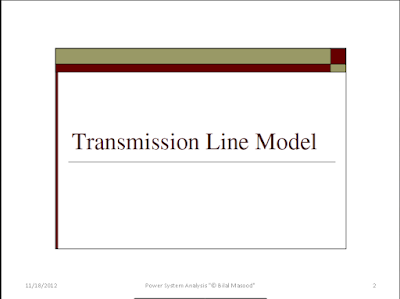A power transmission line with its effective length of around 250 Kms or above is referred to as a long transmission line. Calculations related to circuit parameters (ABCD parameters) of such a power transmission is not that simple, as was the case for a short transmission line or medium transmission line.The reason being that, the effective circuit length in this case is much higher than what it was for the former models (long and medium line) and, thus ruling out the approximations considered there like.
long transmission line
- Ignoring the shunt admittance of the network, like in a small transmission line model.
- Considering the circuit impedance and admittance to be lumped and concentrated at a point as was the case for the medium line model.
Rather, for all practical reasons we should consider the circuit impedance and admittance to be distributed over the entire circuit length as shown in the figure below.
The calculations of circuit parameters for this reason is going to be slightly more rigorous as we will see here. For accurate modeling to determine circuit parameters let us consider the circuit of the long transmission line as shown in the diagram below.
long transmission line model
Here a line of length l > 250km is supplied with a sending end voltage and current of VS and IS respectively, where as the VR and IR are the values of voltage and current obtained from the receiving end. Lets us now consider an element of infinitely small length Δx at a distance x from the receiving end as shown in the figure where.
V = value of voltage just before entering the element Δx.
I = value of current just before entering the element Δx.
V+ΔV = voltage leaving the element Δx.
I+ΔI = current leaving the element Δx.
ΔV = voltage drop across element Δx.
zΔx = series impedence of element Δx
yΔx = shunt admittance of element Δx
Where, Z = z l and Y = y l are the values of total impedance and admittance of the long transmission line.
Therefore, the voltage drop across the infinitely small element Δx is given by
Now to determine the current ΔI, we apply KCL to node A.
ΔI = (V+ΔV)yΔx = V yΔx + ΔV yΔx
Since the term ΔV yΔx is the product of 2 infinitely small values, we can ignore it for the sake of easier calculation.
Therefore, we can write dI ⁄ dx = V y -----------------(2)
Now derivating both sides of eq (1) w.r.t x,
d2 V ⁄ d x2 = z dI ⁄ dx
Now substituting dI ⁄ dx = V y from equation (2)
d2 V ⁄ d x2 = zyV
or d2 V ⁄ d x2 − zyV = 0 ------------(3)
The solution of the above second order differential equation is given by.
V = A1 ex√yz + A2 e−x√yz --------------(4)
Derivating equation (4) w.r.to x.
dV/dx = √(yz) A1 ex√yz − √(yz)A2
e−x√yz ------------(5)
Now comparing equation (1) with equation (5)
Now to go further let us define the characteristic impedance Zc and propagation constant δ of a long transmission line as
Zc = √(z/y) Ω
δ = √(yz)
Then the voltage and current equation can be expressed in terms of characteristic impedance and propagation constant as
V = A1 eδx + A2 e−δx -----------(7)
I = A1/ Zc eδx + A2 / Zc e−δx ---------------(8)
Now at x=0, V= VR and I= Ir. Substituting these conditions to equation (7) and (8) respectively.
VR = A1 + A2 ---------------(9)
IR = A1/ Zc + A2 / Zc ---------------(10)
Solving equation (9) and (10),
We get values of A1 and A2 as,
A1 = (VR + ZCIR) ⁄ 2
And A1 = (VR − ZCIR) ⁄ 2
Now applying another extreme condition at x=l, we have V = VS and I = IS.
Now to determine VS and IS we substitute x by l and put the values of A1 and
A2 in equation (7) and (8) we get
VS = (VR + ZC IR)eδl ⁄ 2 + (VR −
ZC IR)e−δl/2 --------------(11)
IS = (VR ⁄ ZC + IR)eδl/2 − (VR / ZC − IR)e−δl/2--------------- (12)
By trigonometric and exponential operators we know
sinh δl = (eδl − e−δl) ⁄ 2
And cosh δl = (eδl + e−δl) ⁄ 2
Therefore, equation(11) and (12) can be re-written as
VS = VRcosh δl + ZC IR sinh δl
IS = (VR sinh δl)/ZC + IRcosh δl
Thus comparing with the general circuit parameters equation, we get the ABCD parameters of a long transmission line as,
A = cosh δl
B = ZC sinh δl
C = sinh δl ⁄ ZC
D = cosh δl
Book
- Power System Analysis by Grainger and W.D. Stevenson.
- Power System Analysis and Design by J. Duncan Glover,Mulukutla S. Sarma and Thomas J. Overbye.
- Power System Analysis by Hadi Sadat,
- Principles of Power Systems by Mehta.
Author Bilal masood
lecture 09
Type ppt
Availability Available online
For read this book online or Download click the below link



























